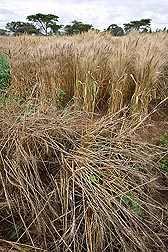Forum—ARS Plays an Integral Role in Combating a Virulent Threat
Agriculture faces constant challenges from nature. Every crop we raise seems to have its own set of insect pests, viruses, diseases, and pathogens just waiting to attack it. Wheat is no exception. One of the most challenging issues facing modern agriculture is a fungal pathogen that threatens the world’s supply of wheat. Ug99 is a type of stem rust that was discovered in Africa, has spread to the Middle East, and is considered by many experts to be the most serious threat to the world’s wheat in the past 50 years. It also infects barley, with spores that can be carried on the wind or travel on the clothing of someone passing by an infected field. It is one of three rust diseases that infect wheat, and it destroys stem tissue so that carbohydrates are unable to reach the grains, causing them to shrivel. Infected plants become covered with rustlike reddish-orange spores.
Ug99 has yet to reach the United States, but we are not immune. Field testing on wheat, conducted by Agricultural Research Service researchers in Africa as part of an international effort, shows that virtually every type of wheat produced in the United States—from the hard red winter wheat of the Southern Plains to the soft white varieties found in the Pacific Northwest—is susceptible.
An epidemic of another type of stem rust destroyed 40 percent of the nation’s spring wheat in the 1950s. Barberry plants harbor that pathogen, and eradicating barberry near the nation’s wheat fields helped turn the tide against major stem rust epidemics years ago. But the threat persists.
In this issue, you will read about efforts at the ARS Cereal Disease Laboratory (CDL) in St. Paul, Minnesota, to probe the genetics of some of wheat’s wild ancestors in a search for genes that will resist Ug99. The hope is that genes can be bred into commercial wheat varieties that will make them resistant. The work is a preemptive strike to ensure that if the disease ever arrives in the United States, wheat producers will be ready for it.
CDL scientists fill a unique niche in what has become an international priority for agricultural scientists. They were part of a team that released a draft of the Ug99 genome and mapped eight resistance genes in wheat that show potential for breeders. They also maintain a collection of stem rust specimens, gathered over the past 50 years during rust surveys of wheat fields, that has proved useful in comparison studies.
Experiments in St. Paul are conducted in mid-winter when it is too cold for escaping spores to survive. When necessary, the researchers work in specially equipped, “contained” greenhouses to ensure that the pathogen poses no risk of escaping into surrounding fields.
The research at St. Paul described in this issue is only one part of an impressive body of work being done by ARS scientists at a number of other sites around the country to help wheat producers and breeders address the threat posed by Ug99. Critical to the effort is the U.S. Small Grains Collection in Aberdeen, Idaho, which is a treasure trove of wheat seeds and plants. It has become a key resource for breeders and researchers from around the world who are looking for new sources of Ug99 resistance. Aberdeen scientists play a critical role in that search, prescreening wheat from the collection to select lines for field testing in Africa that show the most promise. There have also been contributions from several other ARS facilities, including the Plant Sciences Research Unit in Raleigh, North Carolina; the Wheat, Sorghum, and Forage Research Unit in Lincoln, Nebraska; and ARS wheat genotyping laboratories in Fargo, North Dakota; Pullman, Washington; and Manhattan, Kansas.
Wheat breeders generate new varieties each year, and one question they need to address is whether their new varieties will be resistant to Ug99. Field tests of those varieties conducted in Africa by a Raleigh-based ARS researcher have been instrumental in providing guidance to breeders. The publicly available data, on thousands of carefully selected wheat lines, has become a widely used tool.
Evolving pathogens like Ug99 are a good example of why there is such a critical need for research and for development of new wheat varieties. The challenges presented by nature seem to be never-ending. If we are to feed a growing world, we have to be ready for them.
José M. Costa
ARS National Program Leader
Grain Crops
Beltsville, Maryland
"Forum" was published in the April 2014 issue of Agricultural Research magazine.







